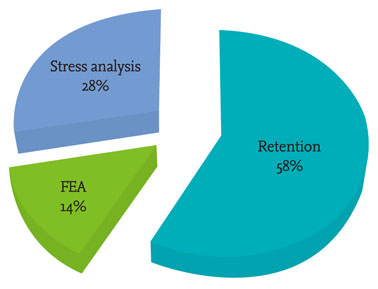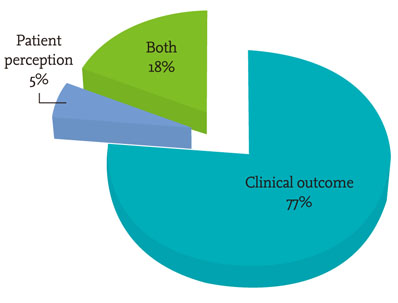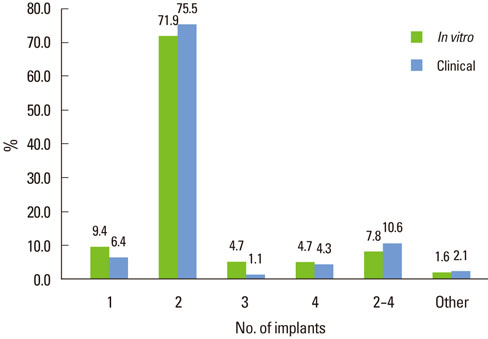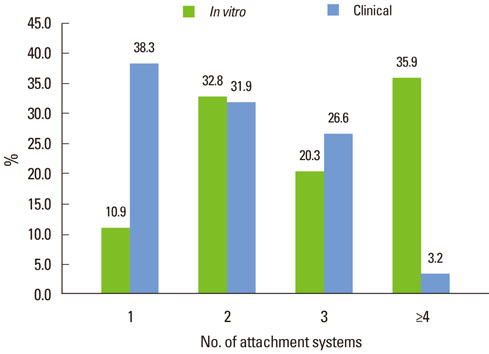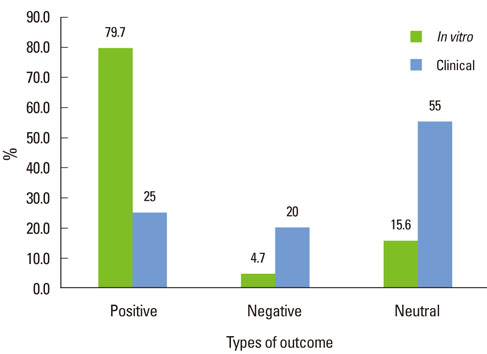J Periodontal Implant Sci.
2013 Feb;43(1):12-17. 10.5051/jpis.2013.43.1.12.
Performance of attachments used in implant-supported overdentures: review of trends in the literature
- Affiliations
-
- 1Department of Restorative Dentistry, University of Illinois at Chicago College of Dentistry, Chicago, IL, USA. dlee6@uic.edu
- KMID: 1783672
- DOI: http://doi.org/10.5051/jpis.2013.43.1.12
Abstract
- The purpose of this review is to examine the performance of attachments used in implant-supported overdenture (IOD) in both clinical and in vitro settings and report the compiled findings, comparisons, and trends in the research literature. Articles published in PubMed on IOD attachment systems and performance were reviewed. Non-original articles were excluded. For each article included, the type of study, number of implants, number of attachment systems, and study outcome were recorded. Of the 283 articles found, 158 met the inclusion criteria. Ninety-four articles were clinical studies and 64 articles were in vitro studies. Studies on retention were the most common for in vitro studies, and four or more attachment systems were compared in most articles with significant differences in outcome. A clinical outcome of one attachment system was most common for clinical studies, while most studies had neutral outcomes overall. Ball attachment was the most commonly tested IOD attachment system. The trend in the literature showed that there is a large discrepancy between the study designs and outcomes between the clinical and the in vitro studies for IOD. Further clinical studies that can validate in vitro research should be encouraged to address this discrepancy between the two areas.
Figure
Reference
-
1. Cehreli MC, Karasoy D, Kokat AM, Akca K, Eckert SE. Systematic review of prosthetic maintenance requirements for implant-supported overdentures. Int J Oral Maxillofac Implants. 2010. 25:163–180.2. Naert I, Alsaadi G, Quirynen M. Prosthetic aspects and patient satisfaction with two-implant-retained mandibular overdentures: a 10-year randomized clinical study. Int J Prosthodont. 2004. 17:401–410.
Article3. Fromentin O, Lassauzay C, Abi Nader S, Feine J, de Albuquerque Junior RF. Testing the retention of attachments for implant overdentures: validation of an original force measurement system. J Oral Rehabil. 2010. 37:54–62.
Article4. Trakas T, Michalakis K, Kang K, Hirayama H. Attachment systems for implant retained overdentures: a literature review. Implant Dent. 2006. 15:24–34.
Article5. Fueki K, Kimoto K, Ogawa T, Garrett NR. Effect of implant-supported or retained dentures on masticatory performance: a systematic review. J Prosthet Dent. 2007. 98:470–477.
Article6. Klemetti E. Is there a certain number of implants needed to retain an overdenture? J Oral Rehabil. 2008. 35:Suppl 1. 80–84.
Article7. Slot W, Raghoebar GM, Vissink A, Huddleston Slater JJ, Meijer HJ. A systematic review of implant-supported maxillary overdentures after a mean observation period of at least 1 year. J Clin Periodontol. 2010. 37:98–110.
Article8. Andreiotelli M, Att W, Strub JR. Prosthodontic complications with implant overdentures: a systematic literature review. Int J Prosthodont. 2010. 23:195–203.9. Jacob RF, Carr AB. Hierarchy of research design used to categorize the "strength of evidence" in answering clinical dental questions. J Prosthet Dent. 2000. 83:137–152.
Article10. Yuan JC, Shyamsunder N, Barao VA, Lee DJ, Sukotjo C. Publication bias in five dental implant journals: an observation from 2005 to 2009. Int J Oral Maxillofac Implants. 2011. 26:1024–1032.11. Hasenboehler EA, Choudhry IK, Newman JT, Smith WR, Ziran BH, Stahel PF. Bias towards publishing positive results in orthopedic and general surgery: a patient safety issue? Patient Saf Surg. 2007. 1:4.
Article12. Verplancke K, De Waele W, De Bruyn H. Dental Implants, what should be known before starting an in vitro study. Sustain Constr Des. 2011. 2:360–369.
Article13. Watters MP, Goodman NW. Comparison of basic methods in clinical studies and in vitro tissue and cell culture studies reported in three anaesthesia journals. Br J Anaesth. 1999. 82:295–298.
Article14. Ding X, Liao SH, Zhu XH, Zhang XH, Zhang L. Effect of diameter and length on stress distribution of the alveolar crest around immediate loading implants. Clin Implant Dent Relat Res. 2009. 11:279–287.
Article15. Alsabeeha N, Payne AG, De Silva RK, Swain MV. Mandibular single-implant overdentures: a review with surgical and prosthodontic perspectives of a novel approach. Clin Oral Implants Res. 2009. 20:356–365.
Article16. Alsabeeha NH, Swain MV, Payne AG. Clinical performance and material properties of single-implant overdenture attachment systems. Int J Prosthodont. 2011. 24:247–254.17. Feine JS, Carlsson GE, Awad MA, Chehade A, Duncan WJ, Gizani S, et al. The McGill consensus statement on overdentures. Mandibular two-implant overdentures as first choice standard of care for edentulous patients. Montreal, Quebec, May 24-25, 2002. Int J Oral Maxillofac Implants. 2002. 17:601–602.18. Thomason JM, Feine J, Exley C, Moynihan P, Muller F, Naert I, et al. Mandibular two implant-supported overdentures as the first choice standard of care for edentulous patients: the York Consensus Statement. Br Dent J. 2009. 207:185–186.
Article19. Geckili O, Bilhan H, Mumcu E. Clinical and radiographic evaluation of three-implant-retained mandibular overdentures: a 3-year retrospective study. Quintessence Int. 2011. 42:721–728.20. Liu J, Pan S, Dong J, Mo Z, Fan Y, Feng H. Influence of implant number on the biomechanical behaviour of mandibular implant-retained/supported overdentures: a three-dimensional finite element analysis. J Dent. 2012. 11. 14. [Epub]. http://dx.doi.org/10.1016/j.jdent.2012.11.008.
Article21. American Dental Association, Commission on Dental Accreditation. Accreditation standards for advanced specialty education programs in prosthodontics. 2008. Chicago: American Dental Association.22. Yuan JC, Kaste LM, Lee DJ, Harlow RF, Knoernschild KL, Campbell SD, et al. Dental student perceptions of predoctoral implant education and plans for providing implant treatment. J Dent Educ. 2011. 75:750–760.
Article23. Lee DJ, Harlow RE, Yuan JC, Sukotjo C, Knoernschild KL, Campbell SD. Three-year clinical outcomes of implant treatments provided at a predoctoral implant program. Int J Prosthodont. 2011. 24:71–76.24. Vere J, Hall D, Patel R, Wragg P. Prosthodontic maintenance requirements of implant-retained overdentures using the locator attachment system. Int J Prosthodont. 2012. 25:392–394.25. Kleis WK, Kammerer PW, Hartmann S, Al-Nawas B, Wagner W. A comparison of three different attachment systems for mandibular two-implant overdentures: one-year report. Clin Implant Dent Relat Res. 2010. 12:209–218.
Article
- Full Text Links
- Actions
-
Cited
- CITED
-
- Close
- Share
- Similar articles
-
- Overdentures using newly designed metal ball attachment containing predetermined gap with stress breakers
- Clinical evaluation of implant retained overdentures using two implant and Locator attachments in the fully edentulous mandibles
- Implant and root supported overdentures - a literature review and some data on bone loss in edentulous jaws
- Fabrication of implant supported overdenture using existing implants: a case report
- Use of polyaryletherketone (PAEK) based polymer for implant-supported telescopic overdenture: A case report

